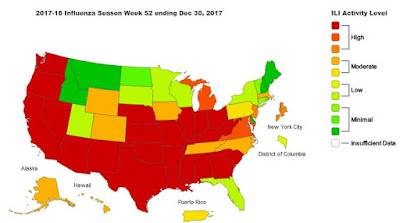#13,034
For the second week in a row the CDC's FluView report shows influenza activity has increased sharply across the nation, with the number of patient visits for ILI (Influenza-like Illness) so far matching the 2014-15 season, but on a pace that seems likely to exceed anything we've seen in recent years.
As always, the FluView report is a snapshot of flu activity more than a week ago, and so the numbers being racked up today are likely higher.
Add in reporting delays over the holidays, and ongoing data collection problems with the P&I Mortality rate (which runs 2 weeks behind the rest of the data) and today's report probably doesn't do this year's flu season justice.In any event, the numbers we have are plenty bad enough. A brief summary shows:
2017-2018 Influenza Season Week 52 ending December 30, 2017If you haven't gotten the flu vaccine, it isn't too late. While it may not protect as well as we'd like against H3N2, influenza B and H1N1 are part of this year's mix, and the vaccine is expected to do much better against those strains.
All data are preliminary and may change as more reports are received.
Synopsis:
During week 52 (December 24-30, 2017), influenza activity increased sharply in the United States.
Viral Surveillance: The most frequently identified influenza virus subtype reported by public health laboratories during week 52 was influenza A(H3). The percentage of respiratory specimens testing positive for influenza in clinical laboratories increased.
Pneumonia and Influenza Mortality: The proportion of deaths attributed to pneumonia and influenza (P&I) was below the system-specific epidemic threshold in the National Center for Health Statistics (NCHS) Mortality Surveillance System.
Influenza-associated Pediatric Deaths: One influenza-associated pediatric death was reported.
Influenza-associated Hospitalizations: A cumulative rate of 13.7 laboratory-confirmed influenza-associated hospitalizations per 100,000 population was reported.
Outpatient Illness Surveillance:The proportion of outpatient visits for influenza-like illness (ILI) was 5.8%, which is above the national baseline of 2.2%. All 10 regions reported ILI at or above region-specific baseline levels. New York City and 26 states experienced high ILI activity; Puerto Rico and nine states experienced moderate ILI activity; the District of Columbia and six states experienced low ILI activity; and nine states experienced minimal ILI activity.
Geographic Spread of Influenza:The geographic spread of influenza in 46 states was reported as widespread; four states reported regional activity; the District of Columbia reported local activity; and Guam, Puerto Rico, and the U.S. Virgin Islands did not report.
(Continue . .. )
If you aren't practicing heavy duty flu hygiene (covering coughs, washing hands, staying home when sick, etc.) and somehow you haven't gotten sick yet, you need to start.
And as we discussed last week, in Yes, We Have No Pandemic . . . But Line Up A Flu Buddy Anyway, now is a good time to form alliances with friends, relatives, and neighbors to help you (and them) get through this flu season.
While it may be too soon to call this year's flu season `epic', the early numbers are very impressive. And not in a good way.


